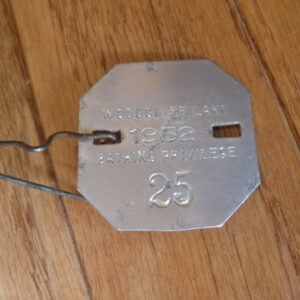For sale is a vintage 1940s Leather HUTCH SPLIT FINGER BASEBALL GLOVE. The printed text on the left-handed leather glove is hard to read but says “HUTCH – Cincinnati, USA – SFR – Oil Treated”. The back of the glove is also stamped “US”. On the back of the thumb, “It’s Hutch Built” is stamped on the thumb. The glove also has a player’s name that runs up the pinky finger but the text is too faint to read. The leather is fairly soft and pliable. A great sports collectible.
In 1875, Charles C. Waite was the first confirmed plyer to use a glove. Because using a glove was considered “weakness” in the early days of the game, Waite used a flesh-colored glove hoping to avoid the ire and embarrassment sure to be handed to him from players and spectators alike. Unfortunately, the coloring wasn’t enough to throw onlookers, and he was ridiculed. The need for baseball gloves started to rise when players experienced more hand injuries. By the 1890s, wearing gloves was a normal and common sight in baseball.
In 1887, Rawlings started to manufacture gloves. In 1919, a St. Louis pitcher named Bill Doak went to Rawlings with an idea to give the glove webbing between the thumb and index finger, an extension of the fingers. Doak sold his patent glove design to Rawlings which turned the baseball glove from only a protective element to also a tool that improved fielding. In 1954, in addition to the web between the thumb and index finger, glove design was further improved by lacing together all of the fingers. The glove for sale has no lacing between the fingers and dates to the 1940s.
The origins of softball date back to around 1889 when people adapted the sport of baseball that could be played indoors. The indoor baseball moved outdoors but the sport was played on a smaller diamond than the traditional baseball fields and sport was called “Indoor-Outdoor”. The game grew in popularity but took off at the end of the 19th century when the Minneapolis Fire Department got ahold of the game as a way to keep firemen fit. Prior to 1926, the sport was known by various names including Kitten Ball, Indoor Ball, Playground Ball, Diamond Ball, Pumpkin Ball, Recreation Ball, Twilight Ball, Army Ball, Lightning Ball, Mushball, Big Ball and Night Ball. In 1926, Walter Hankanson, a Denver YMCA official, coined the name that stuck — Softball. By 1930, Softball was the officially recognized name of the sport.










